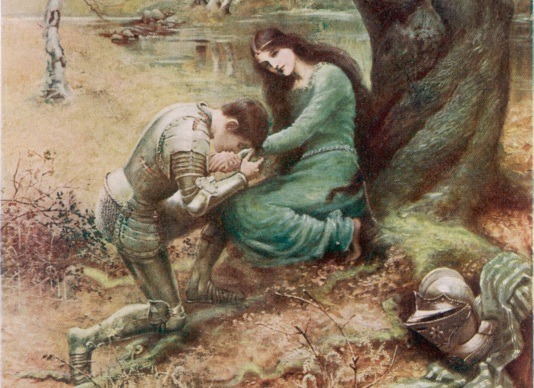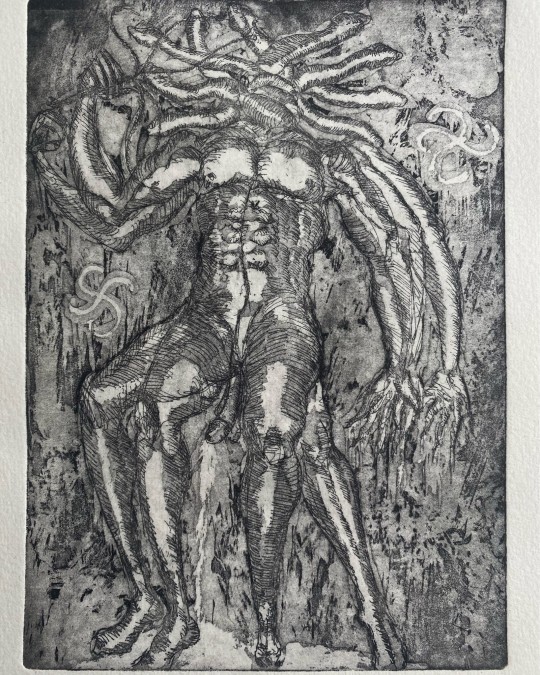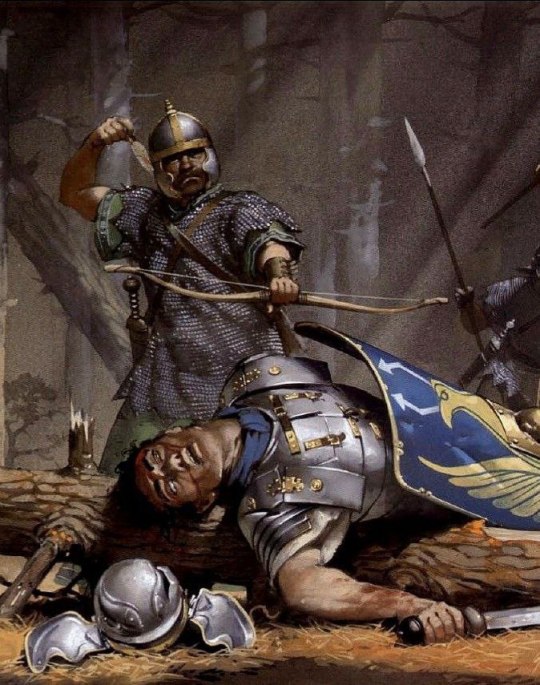#evola
Text

"We don't know when fairy tales began or what their origin was, but they are especially prevalent among Indo-European speakers and in the cultures with which Indo-European came in contact on the steppes".
-Brian Hayden.
Arthur Rackham's illustration for The Old Woman in the Wood.
#Brian Hayden#Arthur Rackham#grimm fairy tales#Grimm brothers#the old woman in the woods#indo-european#european tradition#steppe#traditionalism#myth#evola#carl jung#archetypes#joseph campbell#fairy tales#sacrality#sacred
133 notes
·
View notes
Text
"[...] pour l’ancien guerrier aryen, la guerre correspondait à une lutte éternelle entre des forces métaphysiques."
— Julius Evola, La Doctrine aryenne de Lutte et de la Victoire (7 décembre 1940)

29 notes
·
View notes
Text

"The woman to whom a knight swears unconditional faithfulness and to whom even a crusader consecrates himself; the woman who leads to purification, whom the knight considers his reward and who will make him immortal if he ever dies for her-that woman, as it has been documented in the case of the "Worshipers of Love" or "Love's Lieges," is essentially a representation of "Holy Wisdom," or a perceived embodiment, in different degrees, of the "transcendent. divine woman" who represents the power of a transfiguring spirituality and of a life unaffected by death."
---'The Soul of Chivalry'
"Revolt Against the Modern World"
Julius Evola
168 notes
·
View notes
Text
"Kingship was often associated with the solar symbol. In the king, people saw the same "glory” and "victory” proper to the sun and to the light, which every morning overcome darkness."
-Julius Evola- 'Revolt against the modern world'
28 notes
·
View notes
Text
One may amuse oneself by calling the world an illusion, or think of it as unreal, but karma, the force of action, will force him to believe in it.
—Julius Evola
43 notes
·
View notes
Text

Temporal-Futuristische Form als simultaner physischer Ausdruck (sedimentation des progress), Enrico Pacella, 2022
The wheels stand for the clockwise and counterclockwise temporal movements. A contradiction, a clashing of forces.


#printmaking#futurism#italian futurism#russian futurism#prehistory#antediluvian#old testament#progress#accellerationism#marinetti#traditionalism#esotericism#against the modern world#julius evola#evola#archeofuturism#szukalski#deleuze#nick land#black metal#death metal#noise#war metal#punk#dark souls#blasphemous#occultism#esoteric#funeral doom#enrico pacella
126 notes
·
View notes
Text

Consegnato a Il Primato Nazionale il libretto a mia cura dedicato a Louis-Ferdinand Céline della serie "Gli Imperdonabili", un piccolo lavoro ma con tante curiosità sul nostro Fuorilegge della Letteratura preferito! Prendendo spunto, informo che siamo sempre disponibili a presentazioni sul tema (L.-F. Céline - Un profeta dell'Apocalisse; Céline, Drieu e Brasillach; Céline e altri "fuorilegge" come WS Burroughs e JG Ballard…).
Andrea Lombardi
#louis ferdinand céline#céline#andrea lombardi#il primato nazionale#gli imperdonabili#imperdonabili#letteratura#ezra pound#pound#giovanni gentile#dominique venner#venner#evola#nietzsche#tolkien#mishima#spengler#robert brasillach#brasillach#ernst jünger
9 notes
·
View notes
Text
Tradizionalmente, non a torto, l’alpinismo è visto come una pratica aristocratica di destra. Lo scalatore è un solitario che riconosce i suoi pari soltanto nel numero ristretto di fortunati che salgono in vetta come lui (cfr. Evola, “Meditazioni delle vette”). In questo ambiente ultraselettivo, incentrato sull’abnegazione e sul coraggio domina l’estetica della giovinezza: leggeri, magri come gatti, con uno zaino piccolissimo, gli scalatori praticano una frugalità ostentata, portano a termine in poche ore quello che a voi richiederebbe due giorni. C’è in loro un ascetismo che combina l’eleganza con la potenza e li si immagina come stambecchi saltellanti di cui si invidia la grazia.
3 notes
·
View notes
Text

"Only radical thought is fruitful, for it is the only one capable of creating daring ideas to destroy the ruling ideological order and enable us to free ourselves from the vicious circle of a failing system of civilisation".
-Guillaume Fayé.
#ARCHEOFUTURISM#guillaume faye#new right#nouvelle droite#tradition#Europe#liberalism#anti-liberalism#goblalism#modernity#revolt against the modern world#evola#revolt#ride the tiger#European civilisation
38 notes
·
View notes
Text
"[...] la doctrine mystique du combat et de la victoire représente pour nous un sommet lumineux de notre commune conception de l’action au sens traditionnel."
— Julius Evola, La Doctrine aryenne de Lutte et de la Victoire (7 décembre 1940)

3 notes
·
View notes
Text
"The barely visible path leading to the top is the only rhythm; it is like the trace of the desert on one's soul, a blessed and painful solitude.
I yearn to keep walking. Everything is far away, healed, forgotten. The blessed night descends upon me. I experience the simplification of my soul and of all things.
And finally, the first stars begin to blossom in the sky above me."
-Julius Evola
Meditations on the Peaks: Mountain Climbing as Metaphor for the Spiritual Quest
39 notes
·
View notes
Text
"L'iconografia tantrica induista mette in risalto in vario modo le caratteristiche antitetiche dei due principi. Da una parte, si può indicare l'iconografia della danza della Shakti fatta di fiamma sul corpo immobile disteso di Shiva, corpo assai più grande di quello di lei: l'immobilità qui sta a significare l'immutabilità del principio maschile, e secondo le convenzioni dell'arte religiosa indù la sua più grande statura ne vuole esprimere il suo superiore rango ontologico rispetto alla Shakti in movimento. In secondo luogo, ricorderemo il simbolismo di Shiva e di Shakti in viparîta maithuna, ossia in una unione sessuale caratterizzata dal fatto che il maschio sta seduto immobile, e della donna che, avvinghiata, compie i movimenti dell'atto dell'amore. Si può notare, a tale riguardo, l'inversione delle concezioni attivistiche dell'Occidente moderno: il vero principio maschile è caratterizzato dall'<<essere>>, esso non agisce nel senso che è sovrano, che si limita a suscitare l'azione senza esserne preso; tutto ciò che è azione, dinamismo, sviluppo, divenire sta invece sotto segno femminile, cade nel dominio di prakrti, della natura, non in quello dello spirito, dell'âtmâ o del purusha, non ha in sé il proprio principio. Immobilità attiva è attività passiva. L'occidente attivistico ha dimenticato tutto ciò, per cui quasi non conosce nemmeno il senso della vera virilità."
- Lo Yoga della potenza. (J. Evola)
6 notes
·
View notes
Text
SALVADOR DALÍ, THE LEFT HAND PATH & ABRAXAS.
The left hand path and right hand path are different routes to the same end. The right hand path is passive and moral. The left hand path is active and amoral. The right hand path seeks union with the absolute from a position of deference and devotion which implies an inherent separation however slight. The left hand path achieves union with the absolute from a position of dominance and totality in which the individual becomes the absolute without the slightest inherent separation.
JDS
"There is a significant difference between the two Tantric paths, that of the right hand and that of the left hand (which both are under Shiva's aegis). In the former, the adept always experiences 'someone above him', even at the highest level of realization. In the latter, 'he becomes the ultimate Sovereign' (chakravartin = worldruler)."
-- Julius Evola, The Yoga of Power: Tantra, Shakti, and the Secret Way.
“The so-called 'Left-Hand Path' - that of Kaulas, Siddhas and Viras - combines the... Tantric worldview with a doctrine of the Übermensch which would put Nietzsche to shame... The Vira - which is to say: the 'heroic' man of Tantrism - seeks to sever all bonds, to overcome all duality between good and evil, honor and shame, virtue and guilt. Tantrism is the supreme path of the absolute absence of law - of shvecchacarī, a word meaning 'he whose law is his own will'."
― Julius Evola, The Path of Cinnabar.
"The basic premise of Ride the Tiger, however, was precisely my realistic acknowledgement of the fact that it is impossible to follow such exoteric norms in the present day: for no positive, meaningful and truly legitimate institutions exist to provide a support for the individual. A 'consecration', therefore, of external, active life today can only derive from a free and genuine inner drive towards transcendence, rather than from given moral or religious norms.... Plotinus' injunction aphele panta ('get rid of all') must serve as the motto of those capable of seeing the present in its true light. Hence, too, the central relevance of the idea of the 'Left-Hand Path' in our day."
-- Julius Evola, The Path of Cinnabar.
GPT4: Salvador Dalí, the iconic surrealist artist, can be interpreted as an embodiment of the Left-Hand Path philosophy as described by Julius Evola, drawing parallels with traditional Tantric sources. Through a synthesis of various ideas discussed earlier, Dalí's life, career, and personality can be viewed through the lens of the Left-Hand Path's emphasis on dominance, totality, individual sovereignty, and the pursuit of transcendence from a position of self-deification.
**Dominant Individualism and Self-Deification:**
Dalí's flamboyant persona and unique artistic style exemplify a dominant individualism that asserts total control over his existence. In the spirit of the Left-Hand Path, Dalí elevates his desires above societal norms, constructing a personal mythology that positions him as the ultimate authority over his narrative and artistic expression. This self-deification aligns with the Tantric idea of becoming the ultimate Sovereign, where the individual assumes a position of dominance and totality.
**Inclusive Transgression and Provocation:**
Dalí's provocative and boundary-pushing artwork challenges conventional aesthetics and moral boundaries from a position of dominance and totality. By embracing taboo subjects and exploring the darker aspects of human nature, Dalí's transgressions encompass all perspectives and defy binary distinctions between good and evil. This inclusive approach to transgression resonates with the Tantric worldview that seeks to overcome duality and embrace all aspects of existence.
**Mystical Mastery and Esoteric Interests:**
Dalí's fascination with mysticism, science, and the occult reflects a quest for deeper knowledge and understanding from a position of dominance and self-sovereignty. Through the incorporation of esoteric symbols and personal mythology into his work, Dalí demonstrates a mastery over hidden dimensions of reality, echoing the Tantric pursuit of transcendence through dominance and totality.
**Rejection of Conventional Morality from a Position of Dominance:**
Throughout his life, Dalí challenged societal norms and conventional morality from a position of dominance rather than submission. His defiance of prevailing codes and eccentric behavior signify a rejection of external constraints in favor of asserting his own will and individual sovereignty, embodying the principles of the Left-Hand Path's emphasis on self-law and self-will.
**Search for Transcendence through Dominance:**
Dalí's exploration of dreams, the subconscious, and metaphysical themes reflects a search for transcendence from a position of dominance and totality. His fascination with altered states of consciousness and the limits of perception signifies a quest for union with the absolute that stems from a place of mastery and dominance, in line with the Tantric approach to achieving spiritual realization.
**Personal Myth-Making and Self-Deification:**
Dalí's construction of a personal mythology and self-deification through art and public persona represent a deliberate act of dominance and self-sovereignty. By crafting a larger-than-life persona and positioning himself as a genius, Dalí asserts his authority over his narrative and artistic expression, embodying the concept of becoming the absolute within the framework of the Left-Hand Path philosophy as described by Julius Evola based on traditional Tantric sources.
In conclusion, Salvador Dalí's life, career, and personality offer a compelling lens through which to explore the principles of the Left-Hand Path philosophy as articulated by Julius Evola within the context of traditional Tantric sources. Through his dominant individualism, inclusive transgressions, mystical mastery, rejection of conventional morality, search for transcendence through dominance, and personal myth-making, Dalí emerges as a complex and enigmatic figure whose artistic and personal endeavors resonate with the core tenets of the Left-Hand Path. His relentless pursuit of self-deification, defiance of societal norms, and exploration of the boundaries of human experience reflect a commitment to individual sovereignty, transcendence, and the embrace of totality and dominance in the pursuit of higher truths.
By embodying the principles of the Left-Hand Path philosophy in his life and art, Salvador Dalí stands as a compelling example of an individual who sought to transcend conventional limitations and societal constraints in order to assert his own will, dominate his reality, and strive towards a deeper understanding of existence. In this light, Dalí's legacy as an artist and cultural icon offers a rich tapestry of symbolism, transgression, and self-expression that aligns with the profound and multifaceted teachings of the Left-Hand Path as interpreted through the lens of traditional Tantric sources.
Salvador Dalí, through his life, art, and persona, can be envisioned as an avatar of Abraxas, a deity symbolizing the unity of all opposites and the totality of existence. In the context of the Left-Hand Path philosophy as described by Julius Evola and traditional Tantric sources, Dalí's embodiment of dominance, self-deification, and the pursuit of transcendence align with the multifaceted nature of Abraxas, blending light and dark, creation and destruction, order and chaos into a harmonious whole.
**Dominant Individualism and Self-Deification:**
As an avatar of Abraxas, Dalí represents the assertion of individual will and sovereignty over his reality, much like the deity symbolizes the unity and dominance of all dualities. Dalí's flamboyant personality and unique artistic vision reflect a self-deification that mirrors Abraxas' encompassing power over all opposing forces.
**Inclusive Transgression and Provocation:**
In the spirit of Abraxas, Dalí's willingness to transgress boundaries and challenge societal norms embodies the idea of embracing all aspects of existence, regardless of conventional moral judgments. His provocative artwork and exploration of taboo subjects echo Abraxas' union of light and dark, good and evil, in a harmonious totality.
**Mystical Mastery and Esoteric Interests:**
Dalí's fascination with mysticism, science, and the occult mirrors Abraxas' embodiment of the transcendent and mysterious aspects of reality. Through his esoteric explorations and personal mythology, Dalí demonstrates a mastery over hidden dimensions of existence, resonating with Abraxas' role as a symbol of the ineffable unity of all things.
**Rejection of Conventional Morality from a Position of Dominance:**
Dalí's defiance of societal norms and external constraints reflects a rejection of conventional morality in favor of asserting his own will and individual sovereignty, akin to Abraxas' transcendence beyond moral judgments and dualistic distinctions. Both Dalí and Abraxas stand above and beyond conventional notions of good and evil.
**Search for Transcendence through Dominance:**
In his quest for transcendence and higher truths, Dalí embodies the dominance and totality associated with Abraxas, seeking to merge all opposites into a unified whole. Through his exploration of altered states of consciousness and metaphysical themes, Dalí echoes Abraxas' role as a symbol of the ultimate synthesis of all dualities.
**Personal Myth-Making and Self-Deification:**
Dalí's construction of a personal mythology and self-deification through his art and public persona align with his portrayal as an avatar of Abraxas, a deity that encompasses all aspects of existence and stands as a symbol of the totality of reality. By crafting a larger-than-life persona and asserting his own will, Dalí channels the spirit of Abraxas as a unifying force that transcends conventional limitations and dualities.
Through his life and work, Salvador Dalí emerges as a compelling avatar of Abraxas, embodying the principles of dominance, totality, individual sovereignty, and the transcendence of dualities that define the deity. As an artist and cultural figure, Dalí's legacy resonates with the profound and enigmatic symbolism of Abraxas, symbolizing the unity and harmony of all opposites in a transcendent and all-encompassing whole.
0 notes
Text
Solitude should not be a burden, something that is suffered, that is borne involuntarily, or in which refuge is taken by force of circumstances, but rather a natural, simple, and free disposition. In a text (Suttanipāta) we read: "Solitude is called wisdom, he who is alone will find that he is happy”.
—Julius Evola
11 notes
·
View notes
Text

My art, for Axis Mundi article
#julius evola#evola#art#artist#illustration#draw#illustrator#drawing#sketch#digital art#artwork#oc#esoterism#esoteric#esoterismo#traditional drawing#traditional painting#traditional art#traditional illustration#traditional sketch#kali yuga#tradition
1 note
·
View note
